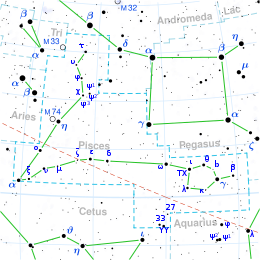Gamma Piscium
| Observation data Epoch J2000.0 Equinox J2000.0 | |
|---|---|
| Constellation | Pisces |
| Right ascension | 23h 17m 09.937s[1] |
| Declination | +03° 16′ 56.25″[1] |
| Apparent magnitude (V) | 3.699[2] |
| Characteristics | |
| Evolutionary stage | Horizontal branch[3] |
| Spectral type | G8 III[4] |
| U−B color index | +0.572 [2] |
| B−V color index | +0.924[2] |
| Astrometry | |
| Radial velocity (Rv) | −13.6[5] km/s |
| Proper motion ( | RA: 759.268 mas/yr[1] Dec.: 17.568 mas/yr[1] |
| Parallax ( | 24.1958 ± 0.2967 mas[6] |
| Distance | 135 ± 2 ly (41.3 ± 0.5 pc) |
| Absolute magnitude (MV) | 0.68±0.08[7] |
| Details | |
| Mass | 0.97±0.12[3] M☉ |
| Radius | 11.28±0.10[4] R☉ |
| Luminosity | 62.7±3.3[4] L☉ |
| Surface gravity (log g) | 2.43 ± 0.06[7] cgs |
| Temperature | 4833±62[4] K |
| Metallicity [Fe/H] | −0.51[7] dex |
| Age | 4.58±3.10[4] Gyr |
| Other designations | |
| Database references | |
| SIMBAD | data |
Gamma Piscium (
Gamma Piscium moves across the sky at three-quarters of an arcsecond per year, which at 135 light years corresponds to 153 kilometers per second.[citation needed] This suggests it is a visitor from another part of the Milky Way Galaxy; in astronomical terms, it will quickly leave the vicinity of the Sun. Its metallicity is only one-fourth that of the Sun, and visitors from outside the thin disk that composes the Milky Way tend to be metal-poor. Gamma Piscium is part of the asterism known as the "circlet of Pisces."[10]
Naming
[edit]In Chinese,
Planetary system
[edit]In 2021, a gas giant planet was detected by the radial velocity method.[12]
| Companion (in order from star) |
Mass | Semimajor axis ( |
Orbital period (days) |
Eccentricity | Inclination | Radius |
|---|---|---|---|---|---|---|
| b | >1.34+0.02 −0.31 MJ |
1.32+0.05 −0.08 |
555.1+6.0 −2.5 |
0.204+0.114 −0.141 |
— | — |
In fiction
[edit]In Frank Herbert's Dune series, the fictional planet of Salusa Secundus, the former home system of Imperial House Corrino and later a prison planet, orbits Gamma Waiping (the Chinese name for Pisces).[citation needed]
References
[edit]- ^ a b c Vallenari, A.; et al. (Gaia collaboration) (2023). "Gaia Data Release 3. Summary of the content and survey properties". Astronomy and Astrophysics. 674: A1. arXiv:2208.00211. Bibcode:2023A&A...674A...1G. doi:10.1051/0004-6361/202243940. S2CID 244398875. Gaia DR3 record for this source at VizieR.
- ^ a b c d Cousins, A. W. J. (1984), "Standardization of Broadband Photometry of Equatorial Standards", South African Astronomical Observatory Circulars, 8: 59, Bibcode:1984SAAOC...8...59C
- ^ a b Fuhrmann, Klaus; Chini, Rolf (January 2022), "On the Brightest Horizontal Branch Population II Star
γ Piscium", Research Notes of the AAS, 6 (1): 14, Bibcode:2022RNAAS...6...14F, doi:10.3847/2515-5172/ac4a78, 14. - ^ a b c d e f g Baines, Ellyn K.; et al. (2018). "Fundamental Parameters of 87 Stars from the Navy Precision Optical Interferometer". The Astronomical Journal. 155 (1). 30. arXiv:1712.08109. Bibcode:2018AJ....155...30B. doi:10.3847/1538-3881/aa9d8b. S2CID 119427037.
- ^ Wielen, R.; et al. (1999), "Sixth Catalogue of Fundamental Stars (FK6). Part I. Basic fundamental stars with direct solutions", Veroeffentlichungen des Astronomischen Rechen-Instituts Heidelberg, 35 (35), Astronomisches Rechen-Institut Heidelberg: 1, Bibcode:1999VeARI..35....1W
- ^ van Leeuwen, Floor (13 August 2007). "Validation of the new Hipparcos reduction". Astronomy & Astrophysics. 474 (2): 653–664. arXiv:0708.1752. Bibcode:2007A&A...474..653V. doi:10.1051/0004-6361:20078357. eISSN 1432-0746. ISSN 0004-6361. Vizier catalog entry
- ^ a b c da Silva, L.; et al. (November 2006), "Basic physical parameters of a selected sample of evolved stars", Astronomy and Astrophysics, 458 (2): 609–623, arXiv:astro-ph/0608160, Bibcode:2006A&A...458..609D, doi:10.1051/0004-6361:20065105, S2CID 9341088
- ^ "* gam Psc". SIMBAD. Centre de données astronomiques de Strasbourg. Retrieved September 30, 2007.
- ^ Liu, Y. J.; et al. (December 2007), "The abundances of nearby red clump giants", Monthly Notices of the Royal Astronomical Society, 382 (2): 553–566, Bibcode:2007MNRAS.382..553L, doi:10.1111/j.1365-2966.2007.11852.x, S2CID 121987595.
- ^ "SPACE.com -- SpaceWatch -- Pisces Rising". Space.com. Archived from the original on July 13, 2010. Retrieved September 30, 2007.
- ^ (in Chinese) AEEA (Activities of Exhibition and Education in Astronomy)
天文 教育 資 訊網 2006年 7月 8日 Archived 2012-04-15 at the Wayback Machine - ^ a b Teng, Huan-Yu; Sato, Bun'ei; Takarada, Takuya; Omiya, Masashi; Harakawa, Hiroki; Izumiura, Hideyuki; Kambe, Eiji; Takeda, Yoichi; Yoshida, Michitoshi; Itoh, Yoichi; Ando, Hiroyasu; Kokubo, Eiichiro (2022), "Regular radial velocity variations in nine G- and K-type giant stars: Eight planets and one planet candidate", Publications of the Astronomical Society of Japan, 74: 92–127, arXiv:2112.07169, doi:10.1093/pasj/psab112

